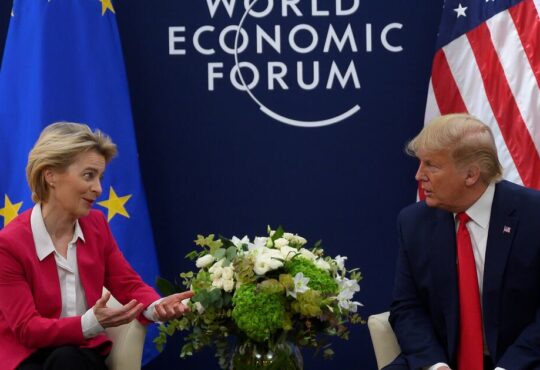
Predicting the end of the US dollar (USD) has become a popular pastime. The reasons for its imminent demise range from past trends (no global currency has lasted more than a century) to the present situation (the US is no longer the superpower it once was). The chief contender for the ‘most powerful currency’ tag seems to be the Chinese renminbi (CNY) though the euro, bitcoin and gold also have some backers. Yet, so far, there has been no dramatic shift away from the dollar. What stops countries from switching to a currency of their choice? We explore the main obstacles to de-dollarization.
Predicting the end of the US dollar (USD) has become a popular pastime. The reasons for its imminent demise range from past trends (no global currency has lasted more than a century) to the present situation (the US is no longer the superpower it once was). The chief contender for the ‘most powerful currency’ tag seems to be the Chinese renminbi (CNY) though the euro, bitcoin and gold also have some backers. Yet, so far, there has been no dramatic shift away from the dollar. What stops countries from switching to a currency of their choice? We explore the main obstacles to de-dollarization.
Multi-currency Trade
Subscribe to Continue Reading
About 40% of international trade is invoiced in US dollars. Using the dollar ensures that traders do not take the risk of buying and selling all the different currencies of their trading partners. Dollar doomsayers argue that the dollar is losing its dominance because more and more international trades are being settled in the renminbi, but this trend should be seen in the right perspective.
When the euro was launched in 1999, it was viewed as a threat to the dollar, because European member states increasingly opted to settle international trade in euros. This was possible because strong European trading nations (such as Germany and the Netherlands) could influence the choice of invoicing currency. Similarly, it is inevitable that China’s rise as a trading power will be followed by more renminbi trade settlement. If India or Vietnam were to become large traders in the future, invoicing in rupees or dongs could pick up too.
The more a currency is used internationally, the more users it attracts, and the deeper it gets entrenched. Transacting with it becomes cheaper as transaction volumes grow. Over time, banking systems and forex markets adapt to working with one or a few leading currencies. A global network develops to enable payments in these currencies. These ‘network effects’ are currently enjoyed by just a few currencies, such as the US dollar and euro.
It’s this network effect that keeps the USD dominant in global payments, and makes CNY’s rise tougher. In global forex markets, between 2010 and 2022, the dollar’s share in forex turnover rose from 84.9% to 88.4%, and CNY’s share increased from 0.9% to 7%. This does not mean that the latter is racing to the top. Over 90% of CNY currency pair transactions were USD/CNY. In other words, CNY turnover may be rising, but the exchange rate itself is quoted against the dollar!
Some industries have specific concerns about de-dollarization. Consider Malaysia, which exported $3.2 billion worth of palm oil to India in 2022-23 until February. Despite the two governments agreeing to trade in rupees, Malaysian palm oil exporters are not willing to accept rupee payments because they do not want exposure to the rupee-ringgit exchange rate, which has been quite volatile since October 2022. Exporters are worried that switching to rupees will generate foreign exchange losses.
The oil and gas industry also prefers dollars, because trading and hedging in crude oil is almost entirely in US dollars. There are reports of the renminbi being used by China for settling some Gulf oil imports and by Pakistan to pay for Russian oil, but these non-dollar deals collectively form a small part of total industry trade.
The current push for de-dollarization is driven by geopolitics and opportunism. It was pioneered by China, which seeks a larger role in global politics, and Russia, which has repeatedly struggled with US-led sanctions. It was welcomed by dollar-scarce emerging economies who saw in it a way to trade or make cross-border payments without depending on the US currency. The result is that world trade has become more multipolar.
Countries that want higher trade or investment from China, or those that don’t have enough dollars, are happy to switch to the renminbi. This is evident from trade data: in March 2023, for the first time, CNY trades overtook dollar trade in China’s bilateral trade transactions. But that’s where it ends. Advanced countries do not promote CNY as an alternative to the dollar as they are not geopolitically aligned with China or Russia. So when it comes to overall global trade, the dollar still leads the way.
The Dollar has been held up, so far, by four factors. One, global central banks hold most of their reserves in US dollars (58% in Q4 2022). Two, the bulk of international trade is in dollars. Three, the breadth, depth and liquidity of US financial markets is unmatched with its free, market-powered movement of capital. Finally, the dollar is trusted because the US has stable institutions, follows the rule of law, and protects free speech and democracy.
China is an export powerhouse, but has a fixed exchange rate and controlled financial markets. Europe is more financially open, but is a union of economically diverse countries. Japan’s stagnant growth does not inspire confidence. The dollar has earned trust by retaining its value through good and bad times. Until an alternative comes along, the dollar remains the king, albeit in a more multipolar world.
The author is an independent writer in economics and finance.




